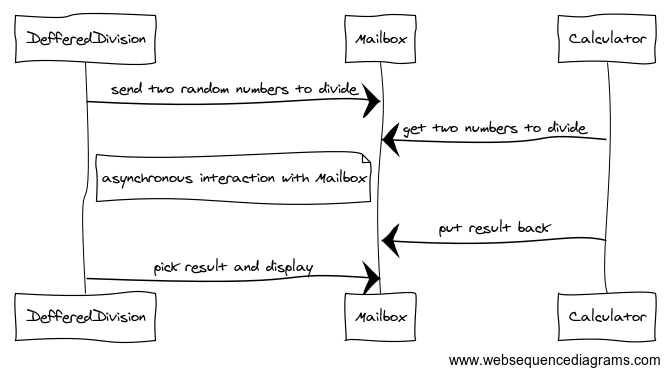A simple Calculator example -pretty naive but then demonstrates using Actor based model in java
In Kilim a thread must extend Task object and implement the execute method which should throw Pausable exception. Kilim weaver (read it as byte code enhancer) interprets classes containing operations throwing Pausable exception and weaves(enhances) it.
import java.math.RoundingMode;
import kilim.Mailbox;
import kilim.Pausable;
import kilim.Task;
public class Calculator extends Task{
private Mailbox mailbox;
public Calculator(Mailbox mailbox) {
super();
this.mailbox = mailbox;
}
@Override
public void execute() throws Pausable, Exception {
while (true) {
Calculation calc = mailbox.get(); // blocks
if (calc.getAnswer() == null) {
calc.setAnswer(calc.getDividend().divide(calc.getDivisor(), 8,
RoundingMode.HALF_UP));
System.out.println("Calculator determined answer");
mailbox.putnb(calc);
}
Task.sleep(1000);
}
}
}
Thread2 - demonstrates sharing of data between Thread1 using a Mailbox
import java.math.BigDecimal;
import java.math.MathContext;
import java.util.Date;
import java.util.Random;
import kilim.Mailbox;
import kilim.Pausable;
import kilim.Task;
public class DeferredDivision extends Task {
private Mailbox mailbox;
public DeferredDivision(Mailbox mailbox) {
super();
this.mailbox = mailbox;
}
@Override
public void execute() throws Pausable, Exception {
Random numberGenerator = new Random(new Date().getTime());
MathContext context = new MathContext(8);
while (true) {
System.out.println("I need to know the answer of something");
mailbox.putnb(new Calculation(
new BigDecimal(numberGenerator.nextDouble(), context),
new BigDecimal(numberGenerator.nextDouble(), context)));
Task.sleep(1000);
Calculation answer = mailbox.getnb(); // no block
if (answer != null && answer.getAnswer() != null) {
System.out.println("Answer is: " + answer.printAnswer());
}
}
}
}
Using Ant invoke Kilim's weaver(byte code enhancer)
A simple test runner
import kilim.Mailbox;
import kilim.Task;
public class CalculationCooperation {
public static void main(String[] args) {
Mailbox sharedMailbox = new Mailbox();
Task deferred = new DeferredDivision(sharedMailbox);
Task calculator = new Calculator(sharedMailbox);
deffered.start();
calculator.start();
}
}
Notice how the same Mailbox is shared between threads without a lock or synchronization
Your output will vary — actors are nondeterministic
[java] I need to know the answer of something
[java] Calculator determined answer
[java] Answer is: The answer of 0.36477377 divided by 0.96829189 is 0.37671881
[java] I need to know the answer of something
[java] Calculator determined answer
[java] Answer is: The answer of 0.40326269 divided by 0.38055487 is 1.05967029
[java] I need to know the answer of something
[java] Calculator determined answer
[java] Answer is: The answer of 0.16258913 divided by 0.91854403 is 0.17700744
[java] I need to know the answer of something
[java] Calculator determined answer
[java] Answer is: The answer of 0.77380722 divided by 0.49075363 is 1.57677330
Sequence Diagram -

Conclusion - As in Scala or Erlang , Actor model can be applied to java.
Also Read
Java development 2.0: Ultra-lightweight Java web services with Gretty
Instrumentation - Querying the memory usage of a Java object
10 things you didn't know about java performance monitoring
5 things you didn't know about java.util.concurrent
The Clean Coder